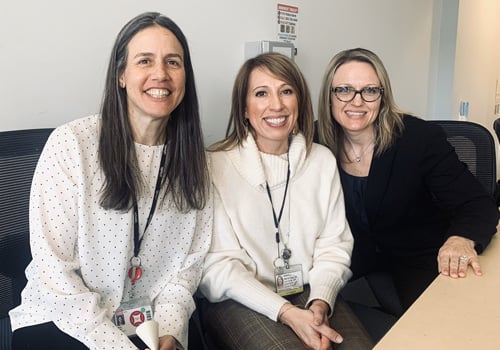With one of the largest academic nurse-midwifery practices in the U.S., CU Nursing’s midwifery enterprise leads the nation in midwifery education, patient care, and research. From a 100% first-time AMCB licensing pass rate of our latest cohort of students to helping birth more than 1,500 babies annually, the program has many achievements to be proud of in its 40-plus year history.
Comprehensive approach leads to innovations in education and practice
This comprehensive approach -- incorporating education, patient care, and research through four academic-owned midwifery centers located in the Denver metro area -- has led to innovations in education and practice. “Education happens within clinical practices, not just in the classroom. Students learn through exposure to a variety of experiences, including more than 2,500 patient encounters. They also see how to manage and run a clinic while using other innovative practice models,” said Amy Nacht, DNP, CNM, MP, FACNM during a recent Grand Rounds presentation by Nacht, Jessica Anderson, DNP, CNM, FACNM, and Denise Smith, PhD, CNM.
Four nurse-run and led midwifery centers
With 34 Certified Nurse Midwives practicing at four collaborative centers (the oldest having been established more than 40 years ago), the practices are unique and exist without physician oversight.
Ground Rounds Midwifery presenters Amy Nacht, Denise Smith & Jessica Anderson
“Even though the midwives do not report to physicians, we need physicians to succeed. We collaborate with MDs especially when a patient becomes high-risk,” said Anderson, the director of the nurse-midwifery practice. The midwifery centers (University Nurse Midwives -- Anschutz Medical Campus, the Center for Midwifery – Anschutz Medical Campus, Center for Midwifery Longmont, and Center for Midwifery Lone Tree locations) all have hospital privileges, and all births occur in the hospital. “Our practices focus on patient safety and preparing our students for the types of situations they will encounter. That’s why we are recognized nationally for achieving an exceptional level of competency,” said Nacht.
The collaborative energy in midwifery is essential in the CU Nursing program. The midwifery clinics partner with other campus schools, healthcare providers, and community leaders. Students also get the opportunity to work with CU School of Medicine students, residents, and faculty in the clinical and simulation environments.
According to Anderson, many nurse-midwifery students are responsible for arranging their own clinic rotation sites. At CU Nursing, the site is part of their education. “We’re frequently contacted by students in other programs to do their clinicals with us. I can’t tell you what an advantage it is to have our clinics as part of the program,” Anderson reports.
Barriers to practice
What continues to set the program apart is its approach to challenges within the profession. Barriers to practice in Colorado include burnout, lack of diversity, as well as interprofessional awareness, recognition, knowledge, and respect for what midwives bring to the labor and delivery experience.
“Being a midwife is more than just a job. It can be exhausting. There’s a high rate of burnout. Also, a third of the Colorado workforce plan on retiring or reducing hours in the next 3-5 years. How do we encourage longevity in practice?” asked Anderson.
Because of the challenges, the program is focusing on developing a healthy workforce, reducing stress, cultivating midwives who reflect the community, and developing partnerships with women’s health and OB/GYN practices – all while encouraging a more collaborative educational environment that brings learners from different disciplines together. “We’re constantly trying to address the question, ‘What gaps can we fill in the community?’” posed Anderson.
That’s why the services have expanded to include women’s health, pregnancy, family planning, as well as the first 28 days of the babies’ life.
Data help prove the case for midwifery practice
“It’s one thing to believe that a practice is viable. It’s another to prove it,” said Smith, nurse-midwifery specialty director. After 40 years of teaching midwifery students while serving the community, CU Nursing’s midwifery practices have years of data showing how midwifery supports high quality care during the peripartum period. During the Grand Rounds presentation, Smith compared 2019 data to national scores and Colorado’s rates fair significantly better. C-section rates for first-time mothers birthing with CU midwives were lower than both state and national averages (16.6% vs. 21% Colorado vs. 25.9% US), and the use of epidurals was significantly reduced (79% nationwide versus 59.3% Colorado). “Our ultimate goal is to create a data set to utilize for research. We want to explore the potential to expand our services throughout the state. To do so, we need to make the case,” said Smith.
“We know we are preparing the next generation of midwives to lead and transform the delivery of women’s health care in Colorado, and we do it in a unique setting that is proven beneficial for students and patients,” said Smith. “Our challenge will be to address barriers within the profession while continuing to provide excellent service.”
For more information on CU Nursing Midwifery.



